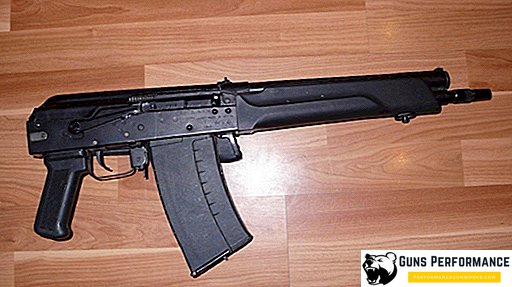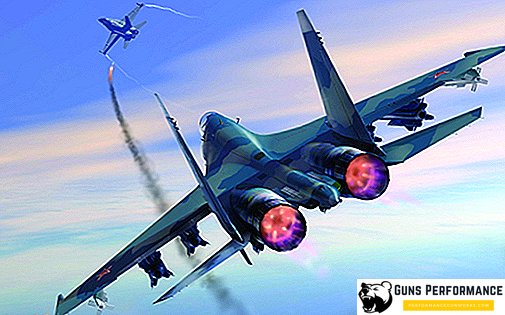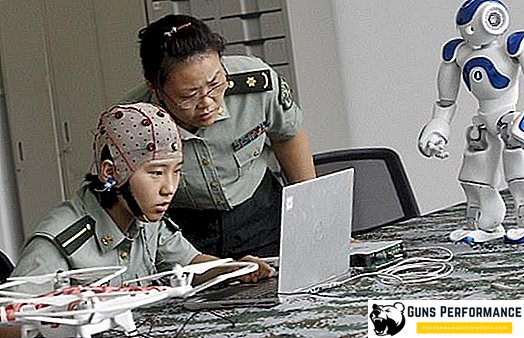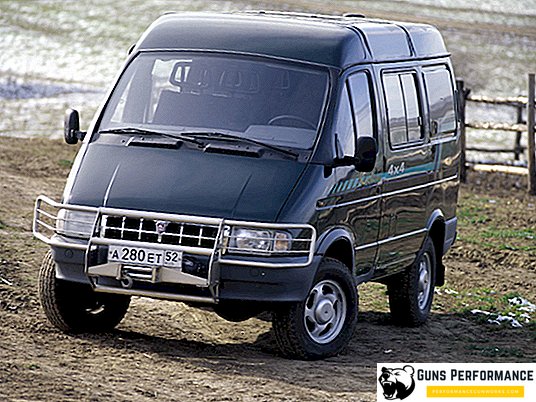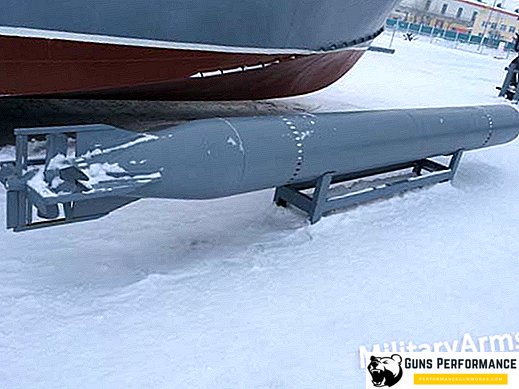More than seventy years have passed since the end of the Second World War - the most terrible conflict in the history of mankind. Few survived those dramatic events, new generations were born and grew up, the world has changed a lot. There was an opportunity for an impartial evaluation of that era. Historians can methodically and smoothly study the details of military operations, note the strengths and weaknesses of the opposing sides, evaluate tactics, and name successful and unsuccessful decisions of the generals.

The same can be said about the weapons of the Second World War. Successful design development were each of the opponents, as well as obvious mistakes. If we talk about the best machine gun of the Second World War, then, without a doubt, it is the German MG.42, which is an example of an excellent combination of reliability, efficiency and technological simplicity in production. He was so good that in a slightly improved form (MG.3) it still remains in service with the Bundeswehr.
History of the MG.42 machine gun
In the twentieth century, war became a real technology competition. This trend is clearly reflected in the development of small arms, which has changed in the first fifty years of the century beyond recognition.
The machine gun (in its modern sense) first appeared at the end of the XIX century, and already the first experience of use showed the high efficiency of this type of weapon. But the real finest hour of the machine gun was the First World War. Machine guns installed on tanks, aircraft, warships. Most of the machine guns of that time had a decent weight, they were installed on special machines or turrets. Basically it was a defensive weapon. At the end of the war, the first large-caliber machine gun (13.35 mm) was created.
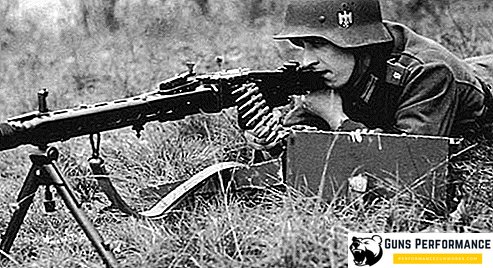
In the period between the world wars, a large number of very successful samples of such weapons appeared: the Vickers machine gun (Great Britain), the Browning machine gun (USA), the ShKAS and the DShK (USSR). All these machine guns subsequently took an active part in the Second World War.
Here are their comparative characteristics:
| Specifications | Light machine guns | Machine guns | ||||
| Machine gun | MG.42 | "Bran" Mk1 | DP-27 | MG.42 | M1919A4 | SG-43 |
| A country | Germany | England | the USSR | Germany | USA | the USSR |
| Cartridge | 7,92×57 | 7,7×56 (.303) | 7,62x53R | 7,92×57 | 7,62×63 | 7,62x53R |
| Mass of weapons with cartridges, kg | 12,6 | 11,5 | 10,6 | 32,1 | 21,55 | 40,4 |
| Machine body length, mm | 1219 | 1150 | 1272 | 1219 | 1041 | 1150 |
| Initial speed of a bullet, m / s | 750 | 745 | 840 | 750 | 853 | 865 |
| Rate of fire, rds / min | 1200 | 660 | 600 | 1200 | 500 | 500-700 |
| Capacity of shop (tape), cartridges | 50 | 30 | 47 | 250 | 250 | 250 |
Work was actively carried out on the creation of the so-called single machine gun, which could perform the functions of a light infantry machine gun, turret, mounted machine guns, or mounted on armored vehicles.
This concept greatly simplified the use of the machine gun, reduced the cost of supply and training of personnel. They dealt with this issue in many countries of the world, but were able to achieve success only in Germany.
The first single machine gun is considered German MG.34. It was created by Rheinmetall AG, and its development took into account the entire experience of using such weapons in the First World War. It could be used with bipods, used in the role of easel, aviation, installed in tanks and other armored vehicles. The machine gun weighed only 12 kg (for comparison, the weight of the Maxim machine gun was 60 kg), so it could be transferred, it could perfectly support the units at the front edge with fire.
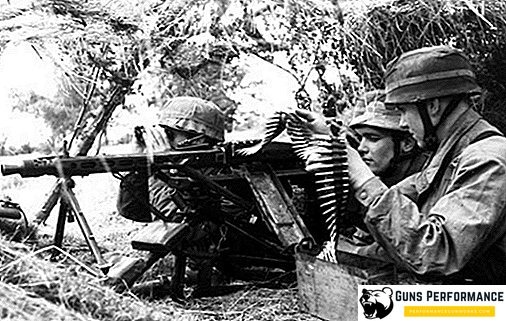
The machine gun had many advantages (it continued to be produced until the very end of the war), but there were also disadvantages.
The main problem of MG.34 was its high cost and rather complicated construction. She had a large number of milled parts that required special types of steel. The cost of one machine gun was 327 Reichsmarks, which was very expensive for that time. The disassembly of the machine gun and its maintenance were quite complicated. For this reason, it was decided to modernize the machine gun, and it began in 1938. The beginning of hostilities in Russia only accelerated this process: MG.34 was very sensitive to pollution, which unpleasantly affected its use on the Eastern Front and in the sands of North Africa.
The little-known company Metall und Lackierwarenfabrik Johannes Grossfuss AG won a victory in the competition for the best upgrade of the machine gun, which was not previously engaged in small arms. After adopting the improved MG.42 model, its production began not only in the factory of the development company, but also in other German factories.
At the end of 1941, the first machine guns of the MG.42 version were sent to the Eastern Front for testing under field conditions, and in 1942 this model was adopted by all branches of the German forces ...
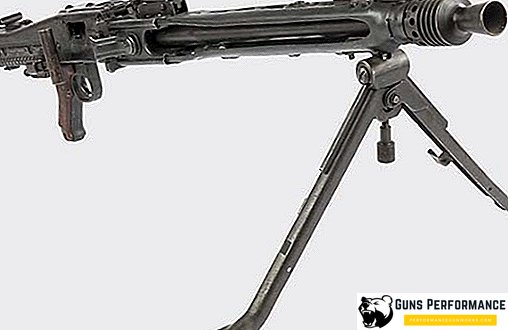
MG.42 can safely be called a wartime weapon, because it was much simpler than MG.34. The machine gun had a large number of stamped parts, which significantly reduced the complexity of its manufacture and cost. Everywhere wherever possible, riveted and screw connections were replaced with spot welding. To produce such a weapon could not even very skilled worker. Wooden butt was replaced by plastic.
At the same time, the simplification did not have a detrimental effect on the efficiency of MG.42. Quite the contrary: the new machine gun turned out to be more reliable and resistant to pollution.
It could be used as a easel, as well as shoot with bipods, mounted on military equipment, use a machine gun as anti-aircraft. MG.34 and MG.42 is very difficult to distinguish in appearance, the "thirty-four" can be recognized by the characteristic round barrel casing. At MG.42 it is angular, stamped.

After the appearance of the first troop MG.42 in the USSR, Soviet intelligence made the wrong conclusion that Germany is running out of resources, and therefore the Germans have to produce such weapons. With resources, Germany was really not very good, but in this case there was an absolutely conscious decision to reduce the cost of weapons.
Production of MG.42 lasted until the very end of the war, about 400 thousand copies were produced. In parallel, there was production of MG 34, because it was better suited for installation on combat equipment.
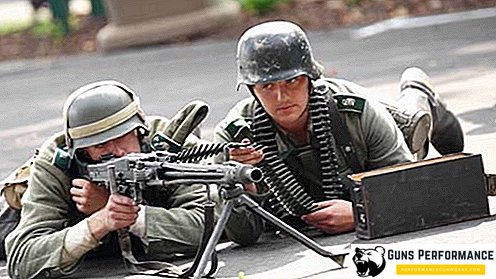
In 1944, work on simplification and cheapening of MG.42 was carried out in Germany. The new modification of the machine gun had a fixed barrel and a semi-free shutter. For the manufacture of new weapons, even low-grade steel could be used, which was very important for Germany at the final stage of the war. German designers managed to reduce the weight of the machine gun to 6.5 kg, that is, even one fighter could easily cope with it. This machine gun was named MG.45, but it could not be launched into mass production. MG.45 had an even higher rate of fire: 2400 rounds per minute. Many developments of this design were later used to develop post-war weapons.
In the late fifties, MG.42 was adopted under the symbol MG.3. It was remade chambered for 7.62 × 51 mm. For this, the barrel and some other elements of the weapon had to be replaced, and numerous minor improvements were made. Due to its high combat performance and manufacturability, this machine gun is still actively exported and manufactured under license in several countries.
The device gun MG.42
The developers of MG.42 were assigned certain tasks: to create the most reliable and cheap in production a single machine gun with a high rate of fire, which would allow achieving high combat power. Some MG.34 elements were used in this machine gun, but you can definitely say that MG.42 is an original and unique weapon.
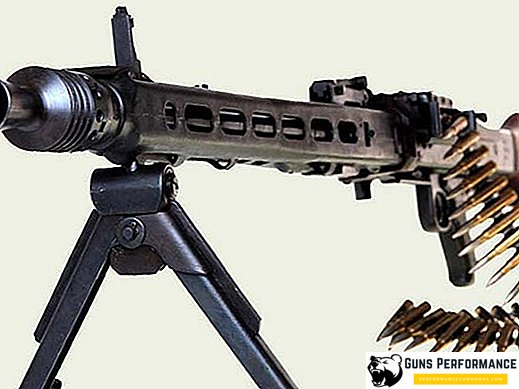
Reduced cost and manufacturability was achieved through the use of cold stamping and spot welding. For example, the barrel of a machine gun was made by stamping from a single blank, while the MG.34 had two separate milled parts.
The cost of the new weapon has decreased by approximately 30%, and the metal consumption - by 50%, the total number of parts has decreased to 200 pieces. In addition to the bolt, muzzle, yoke and whispered all the details of this machine gun made by stamping.
MG.42 works on the principle of recoil barrel with a short stroke. Part of the powder gases is discharged through the muzzle device to enhance the recoil of the barrel after the shot. The special regulator of the muzzle allows you to change the rollback speed of the moving parts of the machine gun, thereby changing its rate of fire. The shot is made at the location of the shutter in the rear position (open shutter).
The cycle begins with the cocking with a very large handle. After pressing the trigger, the bolt moves forward, and sends the cartridge to the chamber. The barrel is locked with the help of two rollers, which are located in the combat larva; they enter special slots in the breech. After they disperse, the striker passes between them, he punctures the primer.
Rollers ensure the smooth operation of the machine gun mechanics, minimize friction, while providing a sufficient support surface.

After the shot, the barrel with the bolt moves back, the rollers in the battle larva are reduced by bevels of the box. The barrel goes even further until the return spring returns it. Special spring-loaded ejector removes the sleeve. Return spring spring pushes the bolt to the front position.
Impact mechanism of the pistol type machine gun, it is located in the bolt. The trigger mechanism is located in the pistol grip, and there is also a push-button fuse that blocks the trigger trigger. The trigger mechanism MG.42 allows to conduct exclusively automatic fire.
The sights of the machine gun consist of an open sight and a front sight. The folding front sight is mounted on the trunk housing, the sight is sector, it has divisions from 200 to 2000 meters with an interval of 100 meters. Homutik sight moved on the bar with a characteristic click, which allowed to set the distance at the hearing, in poor visibility conditions or in the dark.
The length of the sighting line is 430 mm, and the slot of the sight is located at a considerable distance from the butt of the butt (550 mm). On the casing of the machine gun can be mounted a fixed ring-type anti-aircraft sight.
The butt has a characteristic shape ("fishtail"), is on the line of the axis of the trunk, allows for holding with his left hand when shooting from a bipod.
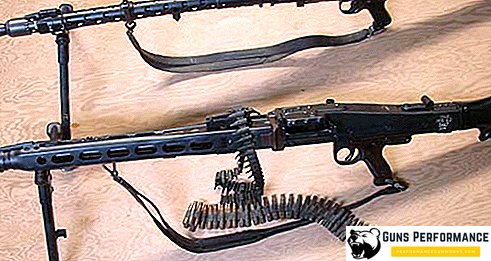
Air cooling of the barrel. The casing of the barrel has characteristic oval holes that improve heat transfer, and on the right side there is a cut-out of almost the entire length of the barrel, through this cut-out it is replaced. The barrel is relatively light, you can quickly change it, the MG.42 takes 5-8 seconds to replace the barrel. To do this, it was necessary to tilt forward the retainer, which was on the right side of the casing. Then the trunk was taken out back, one arm was enough to replace it. To carry out this operation, the machine gunner needed a mitten or a rag, because it was necessary to touch the hot metal.
Cheaper production and an increase in the rate of fire led to a reduction in the duration of barrel survivability. Later, however, his channel began to chrome, which somewhat corrected the situation.
According to the rules, it was necessary to change the barrel every 150 shots (these are three machine-gun belts), otherwise the ballistic properties of the weapon would be reduced. Spare barrels were stored in a special container at the second number of machine-gun bills. Excessive overheating of the barrel could lead to jamming of the cartridge in the chamber.
On the front of the barrel casing, collapsible bipods were attached, the design of which was slightly modified compared to MG.34. Bipods had a hinge, which allowed to put the machine gun on the ground and quickly raise it. The carrying strap was attached to the barrel housing and to the pistol grip.
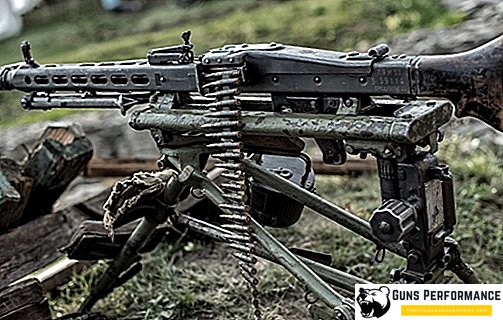
The power of the machine gun was carried out by flexible metal bands with a semi-closed link, similar to the ribbon of the machine gun MG.34. One tape could be attached to another with a cartridge. The length of one tape was 50 rounds. The problem was the control of ammunition consumption, because in a second the weapon released up to 20 cartridges.
Loading a machine gun was a very simple matter. It was necessary to open the lid by pressing the convenient latch (this could be done in mittens), put the cartridge in the correct position and cocking the bolt.
The high rate of fire of the machine gun led to the extensive use of the MG.42 as a lightweight air defense system for infantry, as well as an anti-aircraft machine gun on armored vehicles. On the basis of MG.42 several anti-aircraft installations were created from several machine guns fastened together. In this case, they had a single descent and special sights.
For MG.42 was developed a special machine with three supports "Lafet-42". It was somewhat different from the machine for the MG.34 and was 3 kilograms lighter than it.
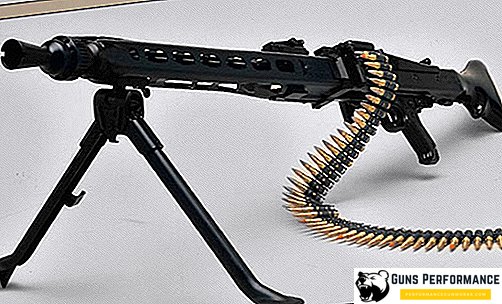
MG.42 application
MG.42 - the main German machine gun of the final stage of the Second World War. This weapon was known for its reliability, unpretentiousness and durability. We can confidently say that in this case, the simplification of the design went to the weapon only for the benefit.
In addition to the general simplification in the design of the machine gun made many changes due to experience with the use of MG.34. The gaps between the parts were increased, making the weapons much more reliable; the large loading handle and the cover latch made it possible to work with them even with warm gloves. A special "winter" descent was developed, which also allowed firing in mittens.
MG.42 was less demanding on the quality of the lubricant, its disassembly and maintenance were easier. Germany prepared for its armed forces a huge number of machine-gunners (until the end of the war, their number was more than 400 thousand people).
However, the main feature of this weapon was its rate of fire. A machine gun could produce from 1200 to 1500 shots per minute. Although dispersion at such a high rate of fire is quite significant, it is not critical. Vibration and impact MG.42 does not interfere with its controllability and does not cause any special complaints.
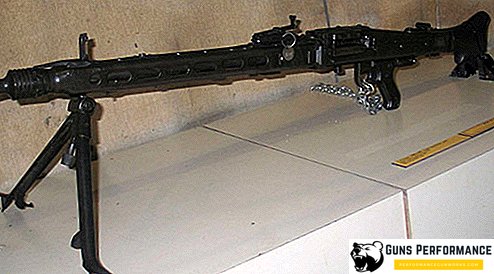
As a rule, the calculation of the machine gun consisted of the first and second numbers, the shooter was attached to them, as well as the carrier of ammunition.
It should be noted that the German field tactics of the time was largely built around a single machine gun. If the Americans and the British put the shooter with a rifle at the forefront, in Germany the machine gunner was the main thing. In the German army, the number of machine guns was the maximum, most of which was exactly MG.42.
Calculation MG.42 could make a solid fire barrier through which the attackers simply could not get through. This lead rain was interrupted only for the time of trunk replacement. American and British soldiers were specifically taught to hide from MG.42 lines and attack while replacing the barrel. The psychological impact of the fire of this machine gun on the enemy soldiers was very large. The Americans released a special training film on how to cope with shock after being under MG.42 fire.
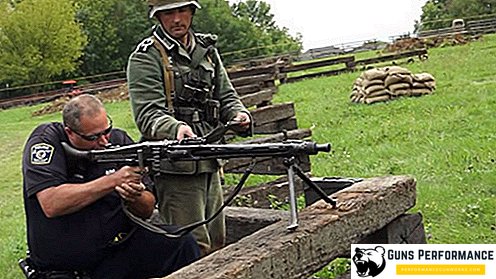
The Americans and the British called this machine gun "Hitler's circular", and the Soviet - "lawn-mower", "widow" and "bone cutter". The Germans themselves called MG.42 "Hitler's saw." Based on these names, one can imagine its deadly effectiveness. The characteristic roaring sound of the work of this weapon brought real horror to the enemy soldiers.
Another unique feature of the MG.42 was the Tiefenfeuerautomat, or automatic fire depth. If the machine gunner assumed that his target was approximately at a distance of 1500 meters, he could adjust the weapon so that the aiming (and fire) occurred from 1300 to 1700 meters and back. While the weapon was firing, the fire was fired precisely at this range.
MG.42 could not conduct a single fire, and for a machine gunner a good indicator was the ability to shoot in bursts of three to five rounds. The German army had strict regulations on how to shoot MG.42. It was forbidden to release more than 250 rounds per line, the optimum rate of fire was considered, at which 300-350 rounds were released per minute. Similar instructions were introduced to reduce barrel wear and increase weapon accuracy.

Summarizing the above, we can conclude that MG.42 is indeed the best single machine gun of World War II. Simplification, which was caused by the lack of resources in Germany, not only did not worsen the characteristics of the machine gun, but even on the contrary, made this weapon even more reliable and effective. MG.42 proved this in the sands of the North Africa and in the snows of the Eastern Front. This may explain the fact that MG.42 modifications are still in service.
Specifications MG.42 / 43
| Performance characteristics | ||
| Name | MG.42 | MG.3 |
| Caliber, mm | 7,62 | 7,62 |
| Overall length, mm | 1230 | 1225 |
| Barrel length, mm | 530 | 565 |
| Total weight, kg | 11,6 | 11,05 |
| Rate of fire, rds / min | 1200-1300 | 900-1300 |
| Early bullet speed, m / s | 710 | 820 |
| Scr. range, m | 2000 | 1200 |




